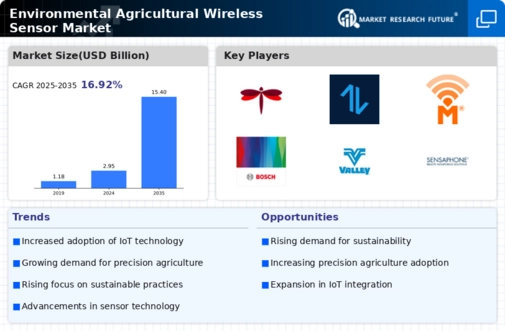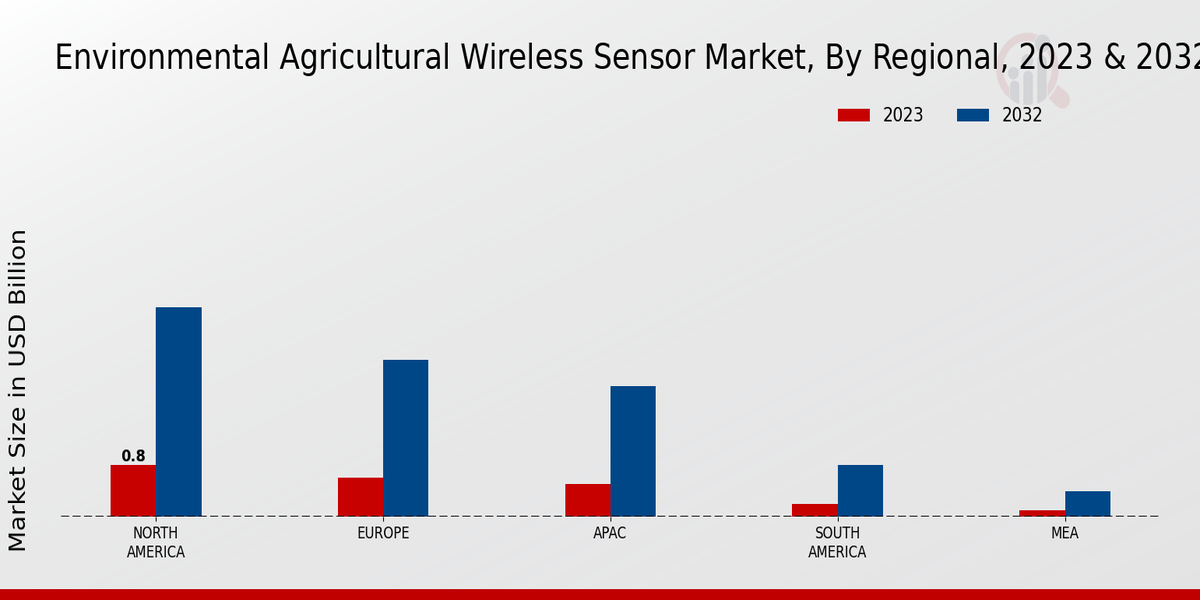Market Growth Projections
The Global Environmental Agricultural Wireless Sensor Market Industry is poised for substantial growth, with projections indicating a rise from 2.95 USD Billion in 2024 to 15.4 USD Billion by 2035. This remarkable increase reflects a compound annual growth rate of 16.19% from 2025 to 2035. Such growth is indicative of the increasing integration of wireless sensor technologies in agricultural practices worldwide, driven by the need for improved efficiency, sustainability, and productivity in food production.
Government Initiatives and Support
Government initiatives aimed at promoting sustainable agricultural practices are playing a pivotal role in the Global Environmental Agricultural Wireless Sensor Market Industry. Various countries are implementing policies that encourage the adoption of wireless sensor technologies to improve agricultural productivity and environmental sustainability. For example, subsidies and grants for farmers investing in smart farming technologies are becoming more common. Such support not only fosters innovation but also drives market growth, as evidenced by the projected compound annual growth rate of 16.19% from 2025 to 2035, indicating a robust future for the industry.
Rising Demand for Precision Agriculture
The Global Environmental Agricultural Wireless Sensor Market Industry is experiencing a surge in demand driven by the increasing adoption of precision agriculture techniques. Farmers are increasingly utilizing wireless sensors to monitor soil moisture, temperature, and nutrient levels, which enhances crop yield and resource efficiency. For instance, the integration of these sensors allows for real-time data collection, enabling farmers to make informed decisions. As a result, the market is projected to reach 2.95 USD Billion in 2024, reflecting a growing recognition of the benefits of precision farming in optimizing agricultural practices globally.
Growing Global Population and Food Demand
The Global Environmental Agricultural Wireless Sensor Market Industry is significantly influenced by the growing global population and the corresponding increase in food demand. As the world population continues to rise, reaching an estimated 9.7 billion by 2050, the pressure on agricultural systems intensifies. Wireless sensors enable farmers to monitor and manage resources more effectively, ensuring that food production keeps pace with demand. This urgent need for enhanced agricultural efficiency is likely to propel the market forward, as stakeholders seek innovative solutions to meet the challenges of food security.
Technological Advancements in Sensor Technology
Technological innovations are propelling the Global Environmental Agricultural Wireless Sensor Market Industry forward. The development of advanced sensor technologies, including IoT-enabled devices, is facilitating more accurate and efficient data collection in agricultural settings. These advancements allow for improved connectivity and data transmission, which are crucial for effective farm management. The market is anticipated to grow significantly, with projections indicating a rise to 15.4 USD Billion by 2035. This growth underscores the potential of emerging technologies to transform agricultural practices and enhance sustainability on a global scale.
Increasing Focus on Sustainable Farming Practices
The Global Environmental Agricultural Wireless Sensor Market Industry is witnessing a heightened focus on sustainable farming practices. As environmental concerns grow, farmers are increasingly seeking solutions that minimize ecological impact while maximizing productivity. Wireless sensors play a crucial role in this transition by providing data that helps optimize resource use, reduce waste, and enhance crop health. This shift towards sustainability is likely to drive market growth, as more stakeholders recognize the importance of integrating technology into environmentally friendly agricultural practices.




















Leave a Comment